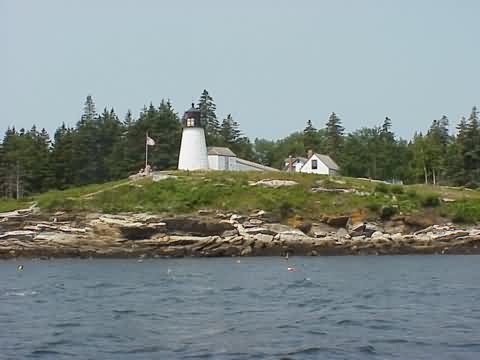|
Last Visited: July, 2002
History:
The Burnt Island Lighthouse is a thirty-foot-high, white, conical tower made of brick and
covered by rubblestone. Its foundation is secured to the natural rock of the Island's southern shore. The base of the tower is fifteen feet in diameter with walls that are four feet thick. The top of the tower measures nine feet, nine inches in diameter with walls that are eighteen inches thick. It is believed that the lantern house was replaced in 1857 with the current 10-sided structure. The 10-foot by 10-foot brick workroom was added to the west side of the tower in 1859.
The Lewis Patent Reflector, a parabolic device, was the original optic that reflected light form the Burnt Island Lighthouse. A lamp, fueled by whale oil, produced the light that reflected out of the lantern room at a focal plane of sixty-one feet above sea level. In 1856, the lighthouse was refitted with a new and improved reflecting apparatus until a suitable Fresnel lens was procured in 1858. The new 4th order glass lens produced a fixed white light. In 1878, the Burnt Island Lighthouse was fitted with new lamps designed to burn kerosene.
In 1888, a dead angle was placed in the lantern room so that light would not be shown to the west-ward of the rocks called the Cuckolds. It appeared that vessels frequently hauled into the harbor as soon as they saw the light, thus striking these rocks, and then moving inexorably closer to the rocky shore. On October 4,1889, the characteristic of the light was changed from fixed white to fixed red, with two white sectors covering the fair-ways or entrances to Boothbay Harbor. The change of color was accomplished by placing ruby red panes of glass in the Lantern room windows. On November 28, 1891 at 4:00 P.M., the characteristic of Burnt Island changed from fixed red, with two white sectors; to flashing red, with two white sectors, every five seconds with a one second flash. It is believed that at this time a new 4th order, 24'' square, bullseye, Fresnel lens was placed in the lantern room. In order to produce this flash, the lens was set on a revolving apparatus that consisted of twenty-one ball bearings and a clock-work mechanism that needed winding every six hours.
When the Burnt Island Lighthouse was electrified in 1961, the square, bullseye lens was replaced with a 375mm glass Fresnel lens that was typically used in lantern buoys. This lens was replaced by the current 300mm plastic Fresnel lens in 1988 when the lighthouse became fully automated.
Source:
History of Burnt Island Light Station, by Waterville Jr. High School

Latitude/Longitude: 43.847287,-69.629568
Directions:
- This lighthouse can only be seen by boat or air. See the Lighthouse Tours page at Cyberlights to find a tour that will take you around Boothbay Harbor.
|




